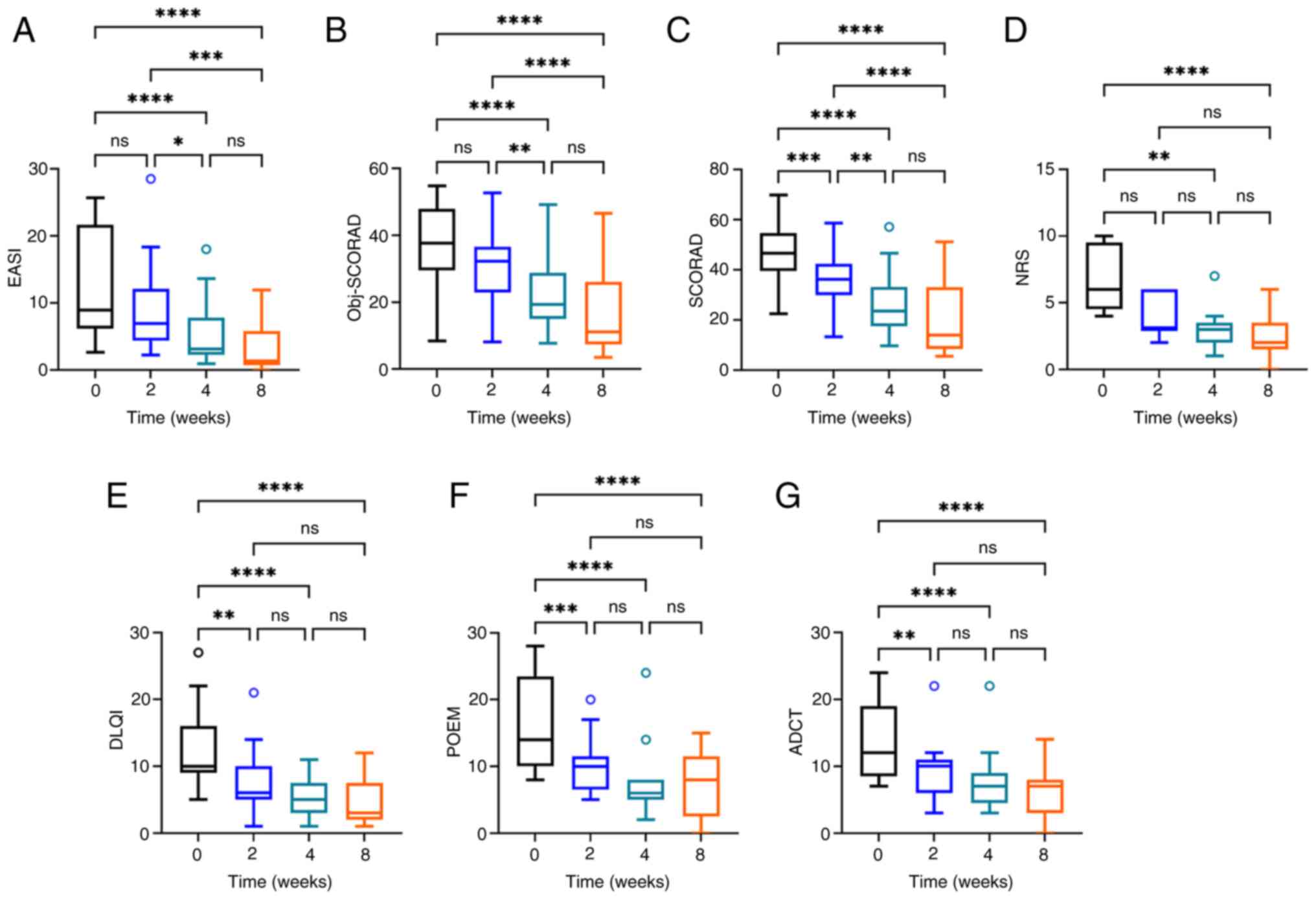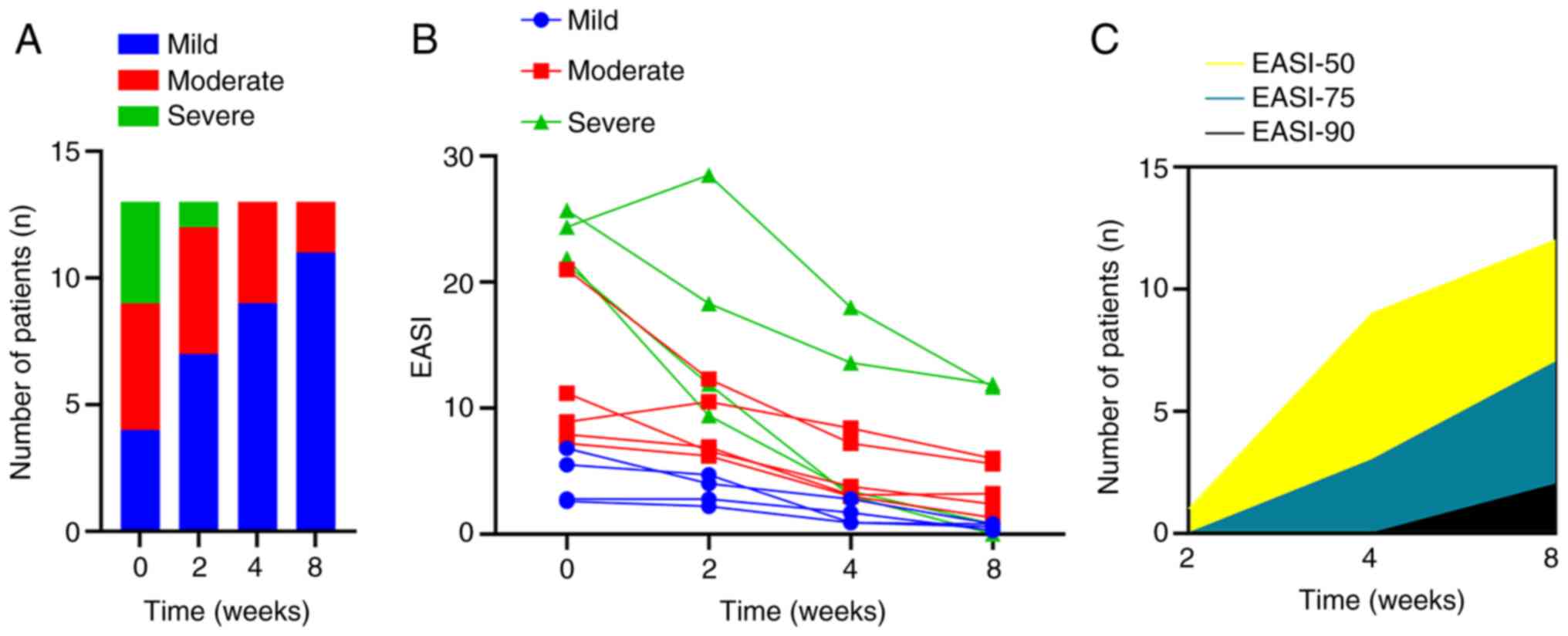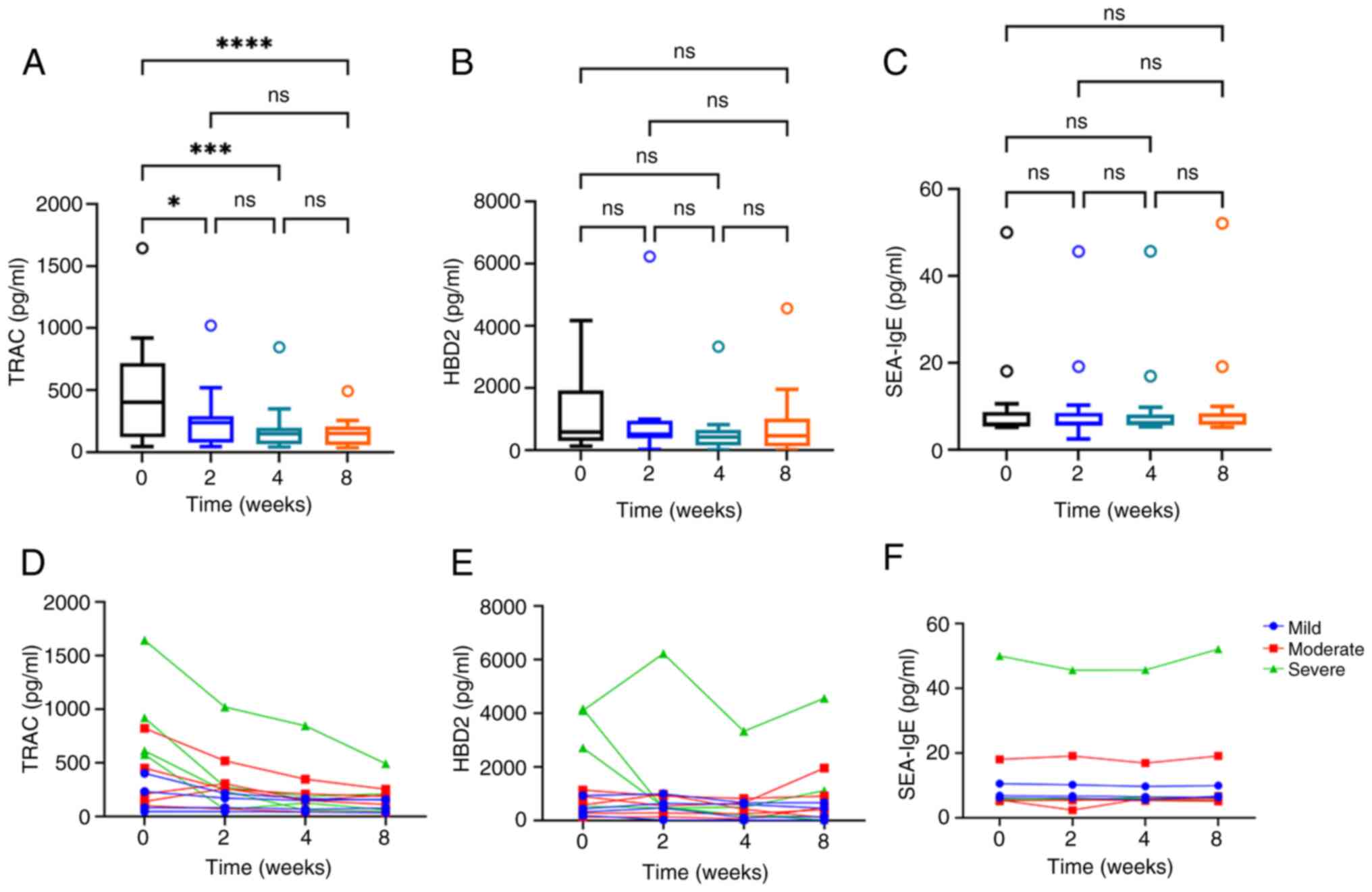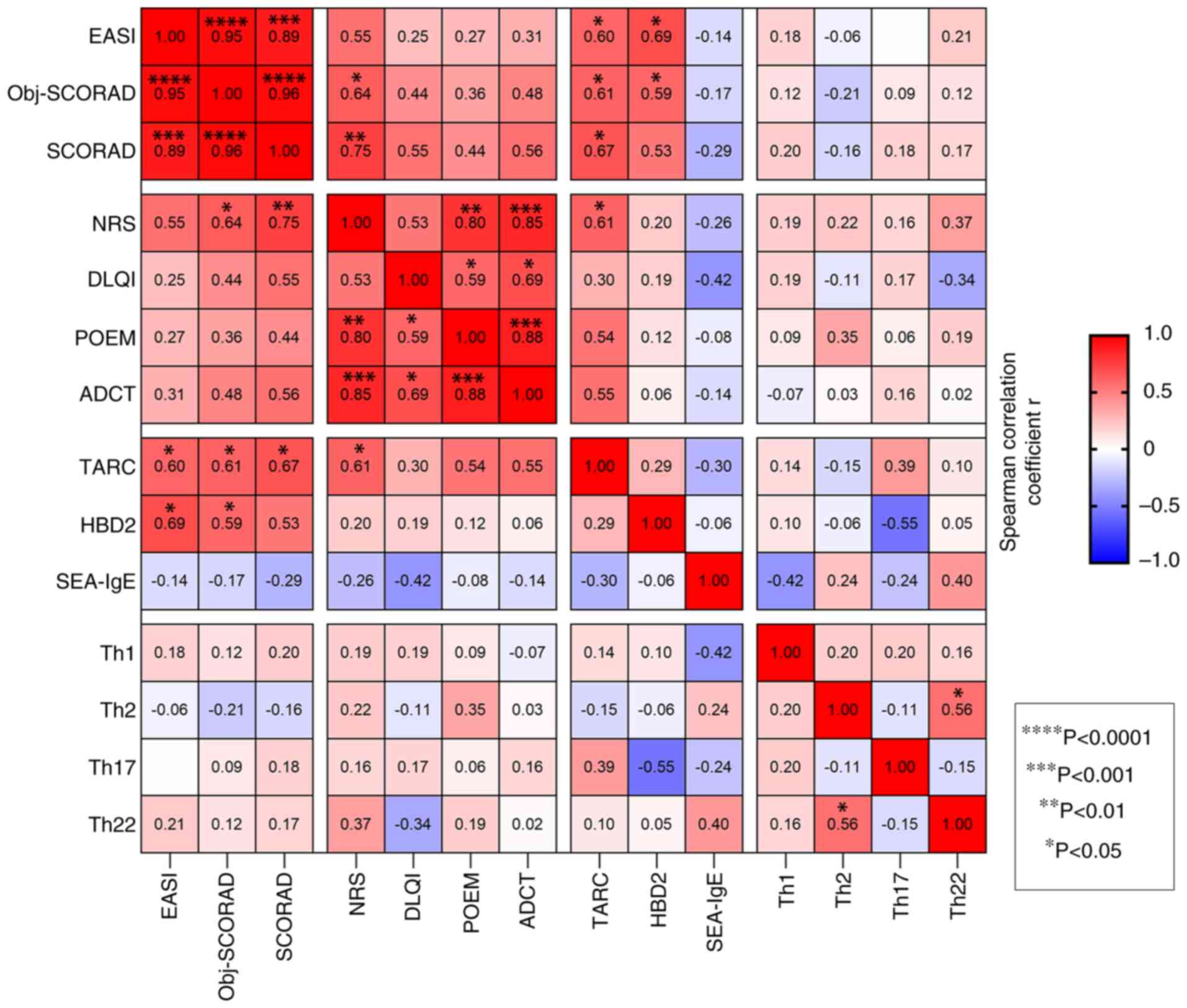|
1
|
Leung DY: Pathogenesis of atopic
dermatitis. J Allergy Clin Immunol. 104:S99–S108. 1999.PubMed/NCBI View Article : Google Scholar
|
|
2
|
Proksch E, Fölster-Holst R and Jensen JM:
Skin barrier function, epidermal proliferation and differentiation
in eczema. J Dermatol Sci. 43:159–169. 2006.PubMed/NCBI View Article : Google Scholar
|
|
3
|
Elias PM: Skin barrier function. Curr
Allergy Asthma Rep. 8:299–305. 2008.PubMed/NCBI View Article : Google Scholar
|
|
4
|
Czarnowicki T, He H, Krueger JG and
Guttman-Yassky E: Atopic dermatitis endotypes and implications for
targeted therapeutics. J Allergy Clin Immunol. 143:1–11.
2019.PubMed/NCBI View Article : Google Scholar
|
|
5
|
Wang HL, Sun J, Qian ZM, Gong YQ, Zhong
JB, Yang RD, Wan CL, Zhang SQ, Ning DF, Xian H, et al: Association
between air pollution and atopic dermatitis in Guangzhou, China:
Modification by age and season. Br J Dermatol. 184:1068–1076.
2021.PubMed/NCBI View Article : Google Scholar
|
|
6
|
Engebretsen KA, Johansen JD, Kezic S,
Linneberg A and Thyssen JP: The effect of environmental humidity
and temperature on skin barrier function and dermatitis. J Eur Acad
Dermatol Venereol. 30:223–249. 2016.PubMed/NCBI View Article : Google Scholar
|
|
7
|
Takai T and Ikeda S: Barrier dysfunction
caused by environmental proteases in the pathogenesis of allergic
diseases. Allergol Int. 60:25–35. 2011.PubMed/NCBI View Article : Google Scholar
|
|
8
|
Jeong SK, Kim HJ, Youm JK, Ahn SK, Choi
EH, Sohn MH, Kim KE, Hong JH, Shin DM and Lee SH: Mite and
cockroach allergens activate protease-activated receptor 2 and
delay epidermal permeability barrier recovery. J Invest Dermatol.
128:1930–1929. 2008.PubMed/NCBI View Article : Google Scholar
|
|
9
|
Dharmage SC, Lowe AJ, Matheson MC, Burgess
JA, Allen KJ and Abramson MJ: Atopic dermatitis and the atopic
march revisited. Allergy. 69:17–27. 2014.PubMed/NCBI View Article : Google Scholar
|
|
10
|
Weidinger S, Beck LA, Bieber T, Kabashima
K and Irvine AD: Atopic dermatitis. Nat Rev Dis Primers.
4(1)2018.PubMed/NCBI View Article : Google Scholar
|
|
11
|
Gittler JK, Shemer A, Suárez-Fariñas M,
Fuentes-Duculan J, Gulewicz KJ, Wang CQ, Mitsui H, Cardinale I, de
Guzman Strong C, Krueger JG and Guttman-Yassky E: Progressive
activation of T(H)2/T(H)22 cytokines and selective epidermal
proteins characterizes acute and chronic atopic dermatitis. J
Allergy Clin Immunol. 130:1344–1354. 2012.PubMed/NCBI View Article : Google Scholar
|
|
12
|
Sugaya M: The role of Th17-related
cytokines in atopic dermatitis. Int J Mol Sci.
21(1314)2020.PubMed/NCBI View Article : Google Scholar
|
|
13
|
Gu H and Zhang JZ: Guideline for diagnosis
and treatment of atopic dermatitis in China. Chinese J Dermatol.
53:81–88. 2020.
|
|
14
|
Noda S, Suárez-Fariñas M, Ungar B, Kim SJ,
de Guzman Strong C, Xu H, Peng X, Estrada YD, Nakajima S, Honda T,
et al: The Asian atopic dermatitis phenotype combines features of
atopic dermatitis and psoriasis with increased TH17 polarization. J
Allergy Clin Immunol. 136:1254–1264. 2015.PubMed/NCBI View Article : Google Scholar
|
|
15
|
Simpson EL, Villarreal M, Jepson B,
Rafaels N, David G, Hanifin J, Taylor P, Boguniewicz M, Yoshida T,
De Benedetto A, et al: Patients with atopic dermatitis colonized
with staphylococcus aureus have a distinct phenotype and endotype.
J Invest Dermatol. 138:2224–2233. 2018.PubMed/NCBI View Article : Google Scholar
|
|
16
|
Sonesson A, Bartosik J, Christiansen J,
Roscher I, Nilsson F, Schmidtchen A and Bäck O: Sensitization to
skin-associated microorganisms in adult patients with atopic
dermatitis is of importance for disease severity. Acta Derm
Venereol. 93:340–345. 2013.PubMed/NCBI View Article : Google Scholar
|
|
17
|
Niebuhr M, Mainardy J, Heratizadeh A,
Satzger I and Werfel T: Staphylococcal exotoxins induce interleukin
22 in human th22 cells. Int Arch Allergy Immunol. 165:35–39.
2014.PubMed/NCBI View Article : Google Scholar
|
|
18
|
Wang B, McHugh BJ, Qureshi A, Campopiano
DJ, Clarke DJ, Fitzgerald JR, Dorin JR, Weller R and Davidson DJ:
IL-1β-induced protection of keratinocytes against staphylococcus
aureus-secreted proteases is mediated by human β-defensin 2. J
Invest Dermatol. 137:95–105. 2017.PubMed/NCBI View Article : Google Scholar
|
|
19
|
Ong PY, Ohtake T, Brandt C, Strickland I,
Boguniewicz M, Ganz T, Gallo RL and Leung DY: Endogenous
antimicrobial peptides and skin infections in atopic dermatitis. N
Engl J Med. 347:1151–1160. 2002.PubMed/NCBI View Article : Google Scholar
|
|
20
|
Kanda N and Watanabe S: Increased serum
human β-defensin-2 levels in atopic dermatitis: relationship to
IL-22 and oncostatin M. Immunobiology. 217:436–445. 2012.PubMed/NCBI View Article : Google Scholar
|
|
21
|
Gu CY, Gu L and Dou X: Serum levels of
thymus and activation-regulated chemokine can be used in the
clinical evaluation of atopic dermatitis. Int J Dermatol.
54:e261–e265. 2015.PubMed/NCBI View Article : Google Scholar
|
|
22
|
Himadri George R, Mathew L, Shanmugam V,
Mani T and Jeyaseelan L: The role of thymus and
activation-regulated chemokine as a marker of severity of atopic
dermatitis. J Am Acad Dermatol. 84:545–547. 2021.PubMed/NCBI View Article : Google Scholar
|
|
23
|
Katoh N, Ohya Y, Ikeda M, Ebihara T,
Katayama I, Saeki H, Shimojo N, Tanaka A, Nakahara T, Nagao M, et
al: Japanese guidelines for atopic dermatitis 2020. Allergol Int.
69:356–369. 2020.PubMed/NCBI View Article : Google Scholar
|
|
24
|
Eshtiaghi P and Gooderham MJ: Dupilumab:
An evidence-based review of its potential in the treatment of
atopic dermatitis. Core Evid. 13:13–20. 2018.PubMed/NCBI View Article : Google Scholar
|
|
25
|
Guttman-Yassky E, Bissonnette R, Ungar B,
Suárez-Fariñas M, Ardeleanu M, Esaki H, Suprun M, Estrada Y, Xu H,
Peng X, et al: Dupilumab progressively improves systemic and
cutaneous abnormalities in patients with atopic dermatitis. J
Allergy Clin Immunol. 143:155–172. 2019.PubMed/NCBI View Article : Google Scholar
|
|
26
|
Callewaert C, Nakatsuji T, Knight R,
Kosciolek T, Vrbanac A, Kotol P, Ardeleanu M, Hultsch T,
Guttman-Yassky E, Bissonnette R, et al: IL-4Rα blockade by
dupilumab decreases staphylococcus aureus colonization and
increases microbial diversity in atopic dermatitis. J Invest
Dermatol. 140:191–202.e7. 2020.PubMed/NCBI View Article : Google Scholar
|
|
27
|
Hendricks AJ, Lio PA and Shi VY:
Management recommendations for dupilumab partial and non-durable
responders in atopic dermatitis. Am J Clin Dermatol. 20:565–569.
2019.PubMed/NCBI View Article : Google Scholar
|
|
28
|
Williams HC, Burney PG, Hay RJ, Archer CB,
Shipley MJ, Hunter JJ, Bingham EA, Finlay AY, Pembroke AC,
Graham-Brown RA, et al: The U.K. working party's diagnostic
criteria for atopic dermatitis. I. Derivation of a minimum set of
discriminators for atopic dermatitis. Br J Dermatol. 131:383–396.
1994.PubMed/NCBI View Article : Google Scholar
|
|
29
|
Atopic Dermatitis Working Group, Group
Immunology, Chinese Society of Dermatology. Yao X, Song Z-Q, Liang
YS, Li W, Zhao Y, Cao H, Chen T, et al: Guidelines for diagnosis
and treatment of atopic dermatitis in China (2020). Int J Dermatol
Venereol. 4:1–9. 2021.
|
|
30
|
Silverberg JI, Lei D, Yousaf M, Janmohamed
SR, Vakharia PP, Chopra R, Chavda R, Gabriel S, Patel KR, Singam V,
et al: What are the best endpoints for eczema area and severity
index and scoring atopic dermatitis in clinical practice? A
prospective observational study. Br J Dermatol. 184:888–895.
2021.PubMed/NCBI View Article : Google Scholar
|
|
31
|
Spuls PI, Gerbens LAA, Simpson E,
Apfelbacher CJ, Chalmers JR, Thomas KS, Prinsen CAC, von Kobyletzki
LB, Singh JA, Williams HC, et al: Patient-oriented eczema measure
(POEM), a core instrument to measure symptoms in clinical trials: A
harmonising outcome measures for eczema (HOME) statement. Br J
Dermatol. 176:979–984. 2017.PubMed/NCBI View Article : Google Scholar
|
|
32
|
Thomas KS, Apfelbacher CA, Chalmers JR,
Simpson E, Spuls PI, Gerbens LAA, Williams HC, Schmitt J, Gabes M,
Howells L, et al: Recommended core outcome instruments for
health-related quality of life, long-term control and itch
intensity in atopic eczema trials: Results of the HOME VII
consensus meeting. Br J Dermatol. 185:139–146. 2021.PubMed/NCBI View Article : Google Scholar
|
|
33
|
Li Y, Lu J, Chen R, Wang Y, Ding Y, Xu S,
Zou Y, Yi X and Shi Y: The efficacy and safety of dupilumab for the
treatment of atopic dermatitis among Chinese patients in clinical
practice: A single-center retrospective study. Dermatol Ther.
35(e15385)2022.PubMed/NCBI View Article : Google Scholar
|
|
34
|
Fargnoli MC, Esposito M, Ferrucci S,
Girolomoni G, Offidani A, Patrizi A, Peris K, Costanzo A, Malara G,
Pellacani G, et al: Real-life experience on effectiveness and
safety of dupilumab in adult patients with moderate-to-severe
atopic dermatitis. J Dermatolog Treat. 32:507–513. 2021.PubMed/NCBI View Article : Google Scholar
|
|
35
|
Olesen CM, Holm JG, Nørreslet LB, Serup
JV, Thomsen SF and Agner T: Treatment of atopic dermatitis with
dupilumab: Experience from a tertiary referral centre. J Eur Acad
Dermatol Venereol. 33:1562–1568. 2019.PubMed/NCBI View Article : Google Scholar
|
|
36
|
Tomczak H, Wróbel J, Jenerowicz D,
Sadowska-Przytocka A, Wachal M, Adamski Z and Czarnecka-Operacz MM:
The role of Staphylococcus aureus in atopic dermatitis:
Microbiological and immunological implications. Postepy Dermatol
Alergol. 36:485–491. 2019.PubMed/NCBI View Article : Google Scholar
|
|
37
|
Totté J, de Wit J, Pardo L, Schuren F, van
Doorn M and Pasmans S: Targeted anti-staphylococcal therapy with
endolysins in atopic dermatitis and the effect on steroid use,
disease severity and the microbiome: Study protocol for a
randomized controlled trial (MAAS trial). Trials.
18(404)2017.PubMed/NCBI View Article : Google Scholar
|
|
38
|
Bangert C, Rindler K, Krausgruber T, Alkon
N, Thaler FM, Kurz H, Ayub T, Demirtas D, Fortelny N,
Vorstandlechner V, et al: Persistence of mature dendritic cells,
TH2A, and Tc2 cells characterize clinically resolved
atopic dermatitis under IL-4Rα blockade. Sci Immunol.
6(eabe2749)2021.PubMed/NCBI View Article : Google Scholar
|
|
39
|
Szegedi K, Kremer AE, Kezic S, Teunissen
MB, Bos JD, Luiten RM, Res PC and Middelkamp-Hup MA: Increased
frequencies of IL-31-producing T cells are found in chronic atopic
dermatitis skin. Exp Dermatol. 21:431–436. 2012.PubMed/NCBI View Article : Google Scholar
|
|
40
|
Boniface K, Bernard FX, Garcia M, Gurney
AL, Lecron JC and Morel F: IL-22 inhibits epidermal differentiation
and induces proinflammatory gene expression and migration of human
keratinocytes. J Immunol. 174:3695–3702. 2005.PubMed/NCBI View Article : Google Scholar
|
|
41
|
Moniaga CS, Tominaga M and Takamori K: The
pathology of type 2 inflammation-associated itch in atopic
dermatitis. Diagnostics (Basel). 11(2090)2021.PubMed/NCBI View Article : Google Scholar
|
|
42
|
Koga C, Kabashima K, Shiraishi N,
Kobayashi M and Tokura Y: Possible pathogenic role of Th17 cells
for atopic dermatitis. J Invest Dermatol. 128:2625–2630.
2008.PubMed/NCBI View Article : Google Scholar
|
|
43
|
Suárez-Fariñas M, Dhingra N, Gittler J,
Shemer A, Cardinale I, de Guzman Strong C, Krueger JG and
Guttman-Yassky E: Intrinsic atopic dermatitis shows similar TH2 and
higher TH17 immune activation compared with extrinsic atopic
dermatitis. J Allergy Clin Immunol. 132:361–370. 2013.PubMed/NCBI View Article : Google Scholar
|
|
44
|
Kishi R, Toyama S, Tominaga M, Kamata Y,
Komiya E, Kaneko T, Suga Y and Takamori K: Effects of dupilumab on
itch-related events in atopic dermatitis: Implications for
assessing treatment efficacy in clinical practice. Cells.
12(239)2023.PubMed/NCBI View Article : Google Scholar
|
|
45
|
Imai Y, Kusakabe M, Nagai M, Yasuda K and
Yamanishi K: Dupilumab effects on innate lymphoid cell and helper T
cell populations in patients with atopic dermatitis. JID Innov.
1(100003)2021.PubMed/NCBI View Article : Google Scholar
|




















